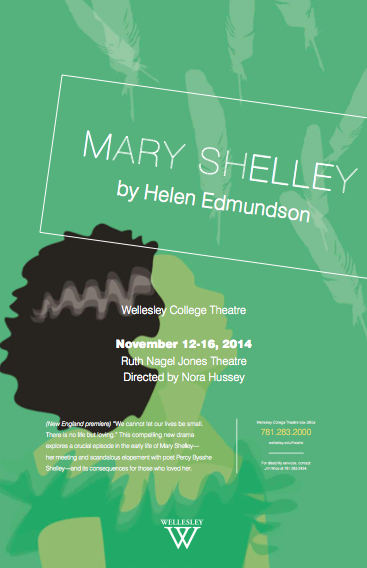
Presented by Wellesley College Theatre
By Helen Edmundson
Directed by Nora Hussey
Nov. 12 – 16, 2014
Wellesley, MA
Wellesley on Facebook
Review by Nick Bennett-Zendzian
(Wellesley, MA) My hat goes off to any company that is mounting a new or otherwise under-produced script. Helen Edmundson’s Mary Shelley received its première staging in Leeds in 2012, followed by a national tour and a run at the Tricycle Theatre in London. Near as I can tell, it has not been mounted in the United States prior to the production currently running at Wellesley College, and I commend director Nora Hussey for bringing this well-crafted play to us.
The play focuses on 16 year-old Mary Wollstonecraft Godwin (Angela Bilkic) and her first encounter with Percy Bysshe Shelley (Woody Gaul), a radical poet and philosopher who is a disciple of Mary’s father William Godwin (John Kinsherf). Percy and Mary fall in love despite their age difference (Percy is 22), opening up a rift between Mary and the rest of her family, spearheaded by William’s vehement disapproval. William refuses to see Mary, and not even the birth of Mary’s first child can bring him around. The play ends with Mary and Percy’s wedding, and William and Mary see each other for the first time in years and take the first steps towards making amends. Mary also tells William that she has just had a novel published. That novel, as it turns out, was Frankenstein.
The play covers a lot of ground, and as such it requires a strong, tight ensemble to carry it through. In Hussey’s director’s note, she highlights the play’s focus on the relationships of these characters in a larger historical context, and how they are influenced and changed by these outside forces. The relationships needed to be stronger than they were in order for this play to be effective. The Godwin family bond needed more work, and the sisters have only begun to scratch the surface in their scenes together. The relationship between Mary and Percy suffers most; the lack of chemistry makes their moments less believable. The actor’s lack of connection to one another detracted from the more meaningful moments of the play. As a result, many of the outbursts on stage felt forced and unmotivated.
Each individual actor has their strong points, however, giving a good outline to each of their characters: Bilkic’s Mary is headstrong and defiant, Chatila’s Jane is sexy and charming, Nazar-Rosen’s Fanny is practical and strong. However, each of them could have been pushed further in these directions. Then, we could have really seen these personalities shine through, which would have helped with the family bond. As some actors need to be pushed farther, others need to be reigned in more. William and Percy’s falling-out moment in Act 1 dissolved into a shouting match, and could have been served better by finding a range of emotions and subtleties. The same holds true for Harriet’s speech to Mary, as she started angry and had nowhere to go.
The play’s technical elements worked to varying degrees of effectiveness. Hussey chose to stage this play in the round, but too much of the action was playing to just one side of the house. From my seat, I saw the backs of the actor’s heads more often than I would have liked. The set was a single unit with minimal pieces, but the layout resulted in awkward transitions that lasted too long. Lighting design worked well to establish time and place, but sometimes actors were not adequately lit during their scenes. There were also too many unnecessary blackouts taking the audience out of the action. The most effective transition took place in Act 2 when the actors for the next scene were beginning to make their entrance to another area of the stage, and the lights shifted from the previous scene to the next with no blackout. Soundscapes also helped with establishing location and action happening off-stage, but in some cases the scene would have been served better if it had not continued under the action for the duration of the scene, such as the ever-present crowd noises in the second scene of Act 1.
All in all, the play is fantastically written. I applaud the company, especially the students, in their handling of this demanding and difficult script. Ultimately, what makes for a memorable performance is trust. Trust the words of the play and trust your fellow performers, and that will always carry you through.
